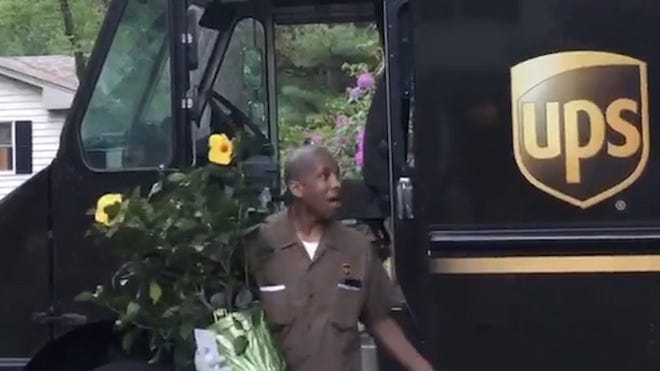Before his political awakening this spring, Peter Diaz lived a quiet life near this leafy liberal bastion at the base of the Puget Sound. He ran a tree-trimming service and a business that built office cubicles. He was 37 and had never voted.
Now he has formed his own political party and is the leader of American Wolf, a roving band of civilians who have anointed themselves “peacekeepers” amid months of tense protests over racism and policing. In the name of law and order, members of his informal group have shot paintballs at demonstrators and carry zip ties and bear spray as they look for antifascists. Diaz has done “recon” in Minneapolis and Seattle’s “autonomous zone,” and drove his American Wolf mobile home to Mount Rushmore to celebrate Independence Day with President Trump.
America’s summer of anxiety and rage has swept up men like Diaz, energizing conservatives who are deploying to the front lines of the culture war. Across the country, conservative armed civilians have surged into public view — marching on statehouses, challenging Black Lives Matter protests, chasing Internet rumors — and bringing the threat of lethal force to local politics. Their emergence has prompted congressional hearings on the surge in anti-government militias and domestic extremism and has alarmed researchers who track hate groups.
Unlike the old image of militiamen as fringe elements motivated by a desire to overthrow the federal government, these groups often rally in defense of the president and see themselves as pro-government allies of local law enforcement.
“We’re the silent majority,” Diaz said, standing outside his house with a .45-caliber Remington handgun on his belt. “It’s time to act.”
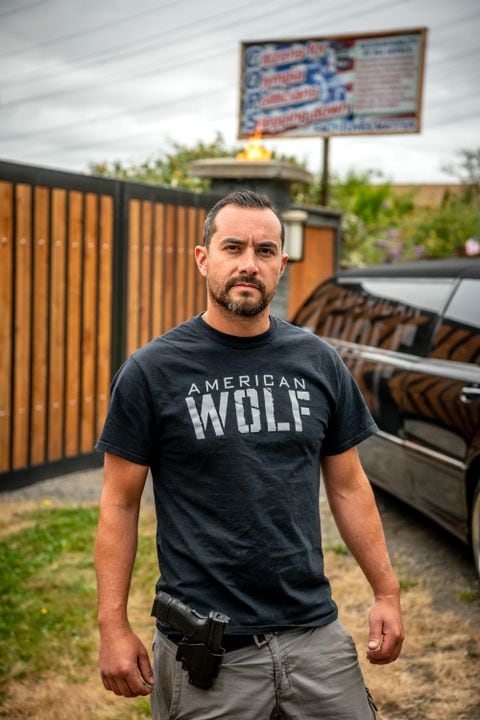 Peter Diaz, 37, formed his own political party and is the leader of American Wolf, a roving band of often-armed civilians who call themselves “peacekeepers” amid weeks of tense protests over racism and policing. (Stuart Isett for The Washington Post)
Peter Diaz, 37, formed his own political party and is the leader of American Wolf, a roving band of often-armed civilians who call themselves “peacekeepers” amid weeks of tense protests over racism and policing. (Stuart Isett for The Washington Post)Many members of these armed groups consider this pre-election period a defining moment. In the pandemic stay-at-home orders, they see government overreach that restricts their freedoms and harms their businesses. In the months of volatile street protests, they see local authorities who lost the nerve to confront violent agitators.
The federal agents clashing with protesters in Oregon are “our Portland heroes,” Diaz wrote on Facebook last week — not performing illegal arrests, as critics have alleged, but making “strategic detentions” of high-value targets. Diaz visited Portland, Ore., earlier this month to offer federal agents free beer and homemade medals of valor as a show of his appreciation.
Gun-toting civilians have stormed the Michigan Capitol demanding the state lift coronavirus restrictions, and rushed to the battlefield in Gettysburg following a flag-burning hoax. After a member of a civilian militia in New Mexico shot and critically injured a man, a prosecutor in Albuquerque earlier this month sued the militia in an attempt to stop it from showing up as a military unit at protests and assuming law enforcement duties.
With a hodgepodge of military garb and over-the-counter assault rifles, such self-styled “patriots” come from lots of backgrounds, but they are predominantly white and male. They are often veterans who say the mission now is to defend the Constitution and the freedoms they fought for in Iraq and Afghanistan.
“I never thought that I’d be in the back of a pickup rolling through downtown Olympia with six guys heavily locked and loaded, armored out,” said Diaz, a former Army reservist. “I’m doing something now that’s for a greater cause than myself. And it feels really . . . good.”
In the Pacific Northwest, far-right and militia-style groups have a long history, but their past standoffs and dramas tended to play out in remote rural settings. During the pandemic and protests, right-wing groups such as the Washington Three Percenters, Proud Boys and Patriot Prayer have held rallies to declare their rights and appeared as counterprotesters at others’ events. Supporters of these groups are running in state and local elections this year in Washington, Oregon, Idaho and elsewhere across the region.
Their appearance at hundreds of events and protests this year across the country is “part of their effort to normalize the presence of armed paramilitaries on the streets, which is a remarkably disturbing turn of events,” said Devin Burghart, president of the Institute for Research and Education on Human Rights, a Seattle-based organization that tracks far-right groups.
“What we’re seeing right now is the outward manifestation of years of organizing by militia-type groups,” Burghart said. “They’ve moved from backwoods training to on-the-streets activism.”

Members of the Proud Boys and other right-wing demonstrators march across the Hawthorne Bridge during a rally to “end domestic terrorism” in Portland, Ore., on Aug. 17, 2019. (Noah Berger/AP)

Albuquerque police detain members of the New Mexico Civil Guard, an armed civilian group, following the shooting of a man during a protest over a statue of Spanish conqueror Juan de Onate on June 15. Protesters clashed with armed men trying to protect the statue. (Adolphe Pierre-Louis/Albuquerque Journal/AP)

“We are not counterprotesters, we’re just going to make sure Coeur d’Alene is safe,” Conrad Nelsen says of the Idaho city as he holds the American flag next to armed citizen Dan Carson, left, during a protest June 2 after the killing of George Floyd. (Kathy Plonka/Spokesman-Review/AP)
TOP: Members of the Proud Boys and other right-wing demonstrators march across the Hawthorne Bridge during a rally to “end domestic terrorism” in Portland, Ore., on Aug. 17, 2019. (Noah Berger/AP) BOTTOM LEFT: Albuquerque police detain members of the New Mexico Civil Guard, an armed civilian group, following the shooting of a man during a protest over a statue of Spanish conqueror Juan de Onate on June 15. Protesters clashed with armed men trying to protect the statue. (Adolphe Pierre-Louis/Albuquerque Journal/AP) BOTTOM RIGHT: “We are not counterprotesters, we’re just going to make sure Coeur d’Alene is safe,” Conrad Nelsen says of the Idaho city as he holds the American flag next to armed citizen Dan Carson, left, during a protest June 2 after the killing of George Floyd. (Kathy Plonka/Spokesman-Review/AP)
Many pro-gun conservatives are rallying around Loren Culp, a small-town sheriff who is a Republican candidate for governor in Washington.
Culp’s profile rose two years ago when he refused to enforce a new state gun law that raised the age to buy semiautomatic rifles from 18 to 21. He declared his small eastern Washington town of Republic a “sanctuary city” for the Second Amendment.
Even in a blue state where former Democratic presidential candidate and two-term Gov. Jay Inslee is expected to win handily, Culp’s rallies in rural Washington towns have attracted hundreds of people. In recent polls, Culp leads among Republicans and has raised more funds than his rivals in the primary apart from one candidate, who self-funded a large portion of his campaign.
“We have to quit enabling the criminals and bring law and order back to our cities and our entire state,” Culp said at a campaign stop in Elma, Wash., last month, speaking from a flatbed truck parked on a paintball grounds. “We have to bring people who have a spine and who understand and have gun leadership in their life.”
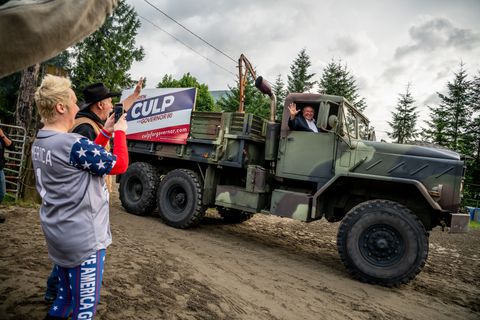 Loren Culp arrives at the July 3 rally in Gold Bar, Wash., in a privately owned U.S. military heavy truck. A couple hundred people attended the event. (Stuart Isett for The Washington Post)
Loren Culp arrives at the July 3 rally in Gold Bar, Wash., in a privately owned U.S. military heavy truck. A couple hundred people attended the event. (Stuart Isett for The Washington Post)The appearance of guns in this tense political moment has not been confined to conservatives. A Black Lives Matter protester who was carrying an assault rifle was shot and killed in Austin by a motorist Saturday night.
During recent unrest in Portland, some protesters have been carrying “powerful slingshots, Tasers, sledgehammers, saws, knives, rifles and explosive devices,” Attorney General William P. Barr told a hearing Tuesday, at which Democrats accused him of sending in federal agents to incite confrontation to benefit Trump’s reelection campaign.
In the Northwest, leftist groups such as the Puget Sound John Brown Gun Club also carried weapons as they escorted speakers or guarded Seattle’s protest encampment in the Capitol Hill neighborhood. There were at least six people shot — and two deaths — in the vicinity of the encampment before it was eventually cleared by police earlier this month.
“We’ve had a few events where Proud Boys have gotten up in our faces and yelled and threatened us,” said Nick, a member of the gun club who gave only his first name, referring to the self-proclaimed “western chauvinists” group that the Southern Poverty Law Center labels a hate group. “They don’t throw punches at us because they know we’re armed.”
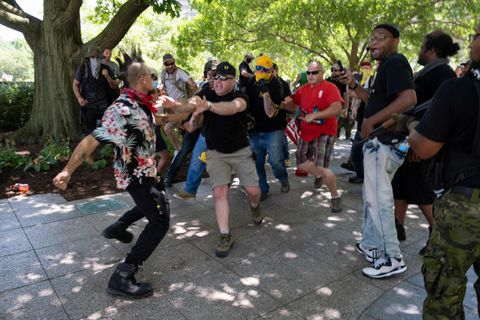 A member of the boogaloo movement, wearing a Hawaiian shirt, gets into an altercation with members of the Proud Boys in front of the Ohio Statehouse in Columbus during an anti-mask protest on July 18. (Jeff Dean/AFP/Getty Images)
A member of the boogaloo movement, wearing a Hawaiian shirt, gets into an altercation with members of the Proud Boys in front of the Ohio Statehouse in Columbus during an anti-mask protest on July 18. (Jeff Dean/AFP/Getty Images)In the foothills of the Cascades, the leader of the Washington Three Percenters was building a lakeside bonfire for a Fourth of July campaign fundraiser for a Republican statehouse candidate. Craig Hanvey, 45, doused the logs in gasoline and took aim with a blowtorch.
The day’s special kindling? A copy of Jon Lee Anderson’s 800-page biography of Che Guevara, the Argentine revolutionary. It was no Marxist tract, but it pictured a Marxist on the cover. The book burst into flames.
“This socialist agenda needs to get reined in,” Hanvey said.
There is a performative, provocateur’s flavor to these groups. At the fundraiser, Hanvey was carrying a handgun and wearing a Hawaiian shirt, the sartorial symbol of the “boogaloo bois,” a fringe movement that anticipates a second American civil war. But Hanvey said he had considered only that it was a warm summer day and the shirt had short sleeves.
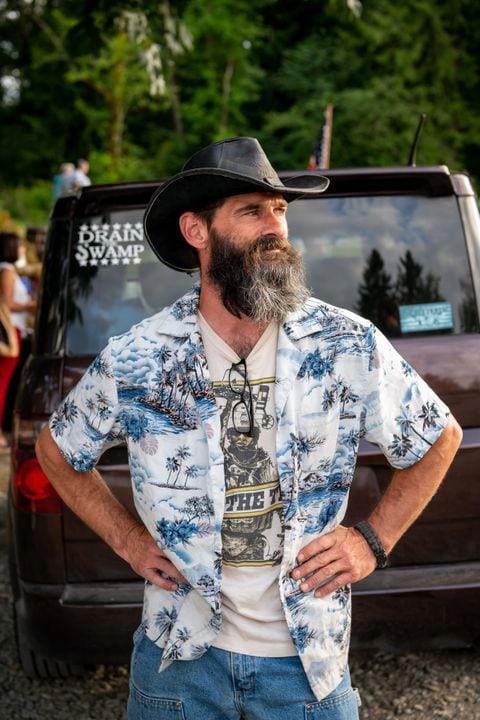 Washington Three Percenters leader Craig Hanvey attends the fundraiser for Matt Marshall in Eatonville, Wash., on July 4. (Stuart Isett for The Washington Post)
Washington Three Percenters leader Craig Hanvey attends the fundraiser for Matt Marshall in Eatonville, Wash., on July 4. (Stuart Isett for The Washington Post)The Washington Three Percenters is an offshoot of the national organization named after the debunked notion that only 3 percent of colonists fought in the American Revolution. The state group, which has 437 members, Hanvey said, appears in public sometimes looking like a military unit, with long guns and body armor. But they bristle if anyone calls them a militia.
Such armed groups have been the target of criticism and, in some cases, ridicule. Last month, the comedian Sacha Baron Cohen turned up unannounced at a pro-gun rally in Olympia organized by far-right groups. Disguised in a long beard and overalls, he sang a song mocking the event. (“Sleepy Joe Biden, what we gonna do? Inject him with the Wuhan Flu” was one of the tamer lines).
“Obviously, they’re trying to prank us and make us look like a bunch of racists,” said Matt Marshall, the founder and former leader of the Washington Three Percenters, who helped organize the rally.
Video of the event was widely shared online and written up in entertainment publications. But the public embarrassment — some in the crowd sang along with Cohen, others booed — was a recruiting boon for the armed group. The following week, more than 200 people requested to join its private Facebook group, Hanvey said.
“We have never had the level of conservative activism that we have now,” Marshall said.
Marshall was the candidate benefiting from the Fourth of July event at a private lakefront home in Eatonville. He has tried to appeal to a broader audience and soften the image of the Washington Three Percenters.
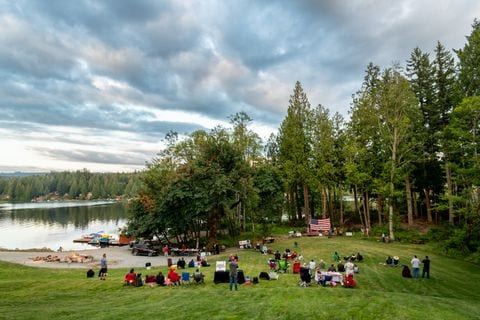 People gather for the fundraiser and Fourth of July barbecue for Matt Marshall in Eatonville, Wash. (Stuart Isett for The Washington Post)
People gather for the fundraiser and Fourth of July barbecue for Matt Marshall in Eatonville, Wash. (Stuart Isett for The Washington Post)Marshall, a former Army medic who served in Afghanistan, was elected to Eatonville’s school board last year. He said he finds the overt military attire counterproductive.
“We’re not winning anybody in the middle by showing up in body armor and military fatigues and AR-15s,” he said. “Nobody’s looking at this and going ‘Oh, these look like the normal people I want to go talk to.’ ”
In speeches, Marshall has preached against racism and in favor of tolerance. He advocates civic duty and civil discourse. He bemoans how social media has helped people demonize their enemies, fostered “cancel culture,” and fomented division in the United States.
“I think the solution is learning to have effective dialogue with members across the aisle, with people who have different ideologies, to come to a mutual understanding, mutual respect,” Marshall said in an interview. “If nobody’s going to listen with honest intent to at least hear the other side, and listen with respect, we’re never going to get anywhere.”
Marshall’s critics see a darker reality beneath the rhetoric. Civil rights groups contend that the Washington Three Percenters is an anti-government militia that promotes conspiracy theories and seeks to undermine democratic institutions.
“We know that their paramilitary presence has served to heighten and escalate tense situations,” said Eric K. Ward, executive director of the Western States Center, which tracks far-right and white nationalist groups. “These are organizations that have created space and protected individuals who are affiliated with white nationalist organizations and ideologies. They certainly haven’t shown responsible leadership.”

Matt Marshall speaks at the fundraiser and Fourth of July barbecue in Eatonville, Wash.

Matt Marshall was the founder of the Washington Three Percenters, an offshoot of the national organization named after the debunked notion that only 3 percent of colonists fought in the American Revolution. (Photos by Stuart Isett for The Washington Post)
LEFT: Matt Marshall speaks at the fundraiser and Fourth of July barbecue in Eatonville, Wash. RIGHT: Matt Marshall was the founder of the Washington Three Percenters, an offshoot of the national organization named after the debunked notion that only 3 percent of colonists fought in the American Revolution. (Photos by Stuart Isett for The Washington Post)
In the small town of Black Diamond, 30 miles southeast of Seattle, two people on the city council are members of the Washington Three Percenters. In Idaho, two men charged in a 2014 armed standoff with federal agents are running for public office.
Recent appearances by armed groups, particularly in liberal-leaning communities, have prompted local scandals.
One night in early June, members of the Three Percenters showed up armed outside an Olympia gun store that had posted on Facebook a warning about riots planned for that night and invited “armed citizenry” to “help secure the business.” Members of the group later appeared in a photo from that night standing alongside an Olympia police officer. The incident sparked outrage in the city, a police investigation, and the officer was suspended.
“It was a complete overuse of force and intimidation,” said Sam Rasmussen, the owner of a restaurant next to the gun shop. “It is not good for a sleepy town to have armed gunmen in it.”
The police chief of Snohomish, a city north of Seattle, was ousted last month, and the mayor is under pressure to resign after welcoming dozens of armed men — one waving a Confederate flag, others with hate group insignia — who congregated on a main street to defend a row of boutiques because of Internet rumors that “Antifa” looters were going to arrive. (They didn’t.)
Groups with openly white nationalist and neo-Nazi views also have appeared as counterprotesters, including at a Black Lives Matter demonstration in Boise, Idaho, last month. Some shouted “heil Hitler” and “white power,” the Idaho Statesman reported.
Joe Evans, a military veteran and Libertarian candidate for Congress, was beaten over the head outside city hall by three members of a motorcycle gang that descended on Boise that day alongside hundreds of other armed white men.
“They were there specifically to attack [Black Lives Matter],” Evans said. “It was obvious they supported white nationalism, white separatism or white supremacy in some form.”
Evans had come to the protest to hear a friend speak and ended up joining a line of people linking arms to separate the “defund the police” rally from the armed counterprotesters. Evans said he has attended several pro-Second Amendment events in the past and has no issues with weapons being present in public, but that the armed men who arrived that day were belligerent and dangerous.
“This is actually the first time we’ve had violence on this scale occur in Boise,” Evans said. “I’m good for spirited debate. I love it. That’s important. But what happened [June 30] was unprecedented and extremely inappropriate for the way we normally do business here.”
The six square blocks in Seattle that became known as the Capitol Hill Organized Protest (CHOP) also provoked a response from conservative armed groups, who saw the protest site as a flagrant destruction of private property and a sign that authorities couldn’t be trusted to maintain order. Members of the Proud Boys, known for the group’s violent clashes in Portland, walked through the tent camp, provoking screaming matches, and other armed civilians surveilled the site, according to people present.
Trump has fanned the outrage, tweeting that the Seattle protesters were “domestic terrorists” and urging Washington authorities to “Take back your city NOW.”
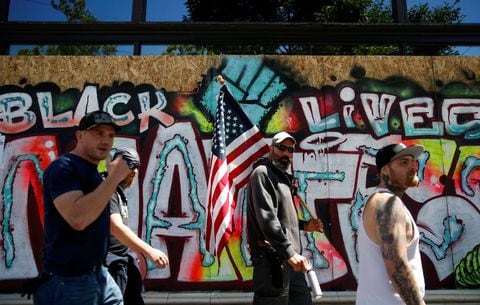 Men walk by a Black Lives Matter mural near the former Capitol Hill Occupied Protest (CHOP) area in Seattle on the Fourth of July. (Lindsey Wasson/Reuters)
Men walk by a Black Lives Matter mural near the former Capitol Hill Occupied Protest (CHOP) area in Seattle on the Fourth of July. (Lindsey Wasson/Reuters)In early July, a few days after police cleared the protest zone, a few dozen people calling themselves “patriots” showed up near the site, some openly carrying guns, waving Trump flags and American flags.
A larger crowd of protesters swarmed around them, shouting “Go home fascists,” and taunting them for several blocks as they walked away. The patriots fired pepper spray in their retreat.
Robert Nielsen, a 33-year-old disc jockey, coughed on the fumes as he watched the patriots disperse.
He had grown up in a conservative family in rural Idaho and said that the autonomous zone protests were necessary even though he didn’t approve of the vandalism and graffiti against local businesses. “My sister is dating a black guy right now and she can’t go home,” he said. “It’s sad.”
“I think we need to keep following through,” he said of liberal protesters like himself. “Our voices weren’t being heard peacefully protesting. So it’s like, what do you do?”

City crews dismantle the CHOP area outside of the Seattle Police Department’s vacated East Precinct on July 1. (David Ryder/Getty Images)

A woman displays her Trump 2020 T-shirt while being confronted by protesters as the group marches in the former CHOP area in Seattle on July 4. (Lindsey Wasson/Reuters)

A man carrying an American flag holds a can of pepper spray after using it on protesters during a confrontation near the former CHOP area in Seattle on July 4. (Lindsey Wasson/Reuters)
TOP: City crews dismantle the CHOP area outside of the Seattle Police Department’s vacated East Precinct on July 1. (David Ryder/Getty Images) BOTTOM LEFT: A woman displays her Trump 2020 T-shirt while being confronted by protesters as the group marches in the former CHOP area in Seattle on July 4. (Lindsey Wasson/Reuters) BOTTOM RIGHT: A man carrying an American flag holds a can of pepper spray after using it on protesters during a confrontation near the former CHOP area in Seattle on July 4. (Lindsey Wasson/Reuters)
Before police moved in to clear out Seattle’s autonomous zone, Peter Diaz had been working on his own plan to solve it.
The Olympia businessman-turned-leader of American Wolf had sent members of his team to the protest on reconnaissance missions. He said he had planned to hire 50 construction workers and two helicopters, and build a wall around the protest to cut off supplies until protesters surrendered or starved. He had sketched out a $10,000 budget for the effort.
“The only live fire rifles would be in the helicopters, as a show of … force,” he explained. “And then have the nonlethal on the ground and pull up in five different 10-man stations and build a wall around CHOP, one block back, and say: We’re going to allow everybody to come and go as they like, but we’re not going to let in any supplies.”
Diaz eventually called off his plan. But his brand of belligerent civilian freelancing has alarmed authorities in Olympia, a predominantly white and liberal city.
Dozens of local officials including Olympia Mayor Cheryl Selby (D) signed an open letter last month condemning American Wolf and other militia-style groups as “armed vigilantes” that have “created a climate of fear” in the state capital. Diaz responded by calling the local officials “treasonous politicians” and filmed himself urinating on a copy of their letter.
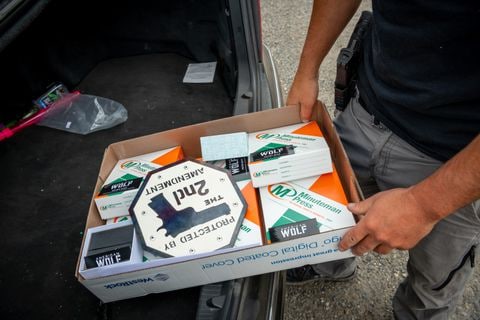 Peter Diaz shows his business cards for American Wolf, a group he leads made of often-armed civilians who have deployed themselves to protests over racism and policing. (Stuart Isett for The Washington Post)
Peter Diaz shows his business cards for American Wolf, a group he leads made of often-armed civilians who have deployed themselves to protests over racism and policing. (Stuart Isett for The Washington Post)One night in late June, Diaz heard Black Lives Matter protesters were attempting to set up an autonomous zone in Olympia. He jumped in his truck.
“I was just like, ‘Oh no they’re not,’ ” he recalled.
Diaz drove his truck through the caution tape that had been strung up, pulled out a knife, and began arguing with protesters, mostly teens and people in their 20s, he said. Amid the yelling, Diaz said he and other members of his group were prodded with umbrellas and then he was Maced in the face. The incident was captured on video.
“One of my guys stepped up and goes bap, bap, bap, bap — and shoots four paintballs directly into the group,” he said.
At least one young person was hit with a paintball in the upper thigh.
“It was at very close range,” the person said, speaking on the condition of anonymity out of fear of reprisal. “It left a nasty bruise.”
“I think it’s pretty blatantly racist to oppose a Black Lives Matter protest and to wield guns against people who aren’t armed,” the person added. “It’s fair to say they’ve also terrorized the town and made a lot of people feel uncomfortable about going into town and made people feel like they can’t be safe while standing up for black lives.”
Diaz denies that he is racist, saying he is the son of a Mexican immigrant. There are also black members of American Wolf.
Diaz conceded that he was “a little bit more aggressive than I needed” to be, but said he was angry about being sprayed. His group also has been the victim of violence. During a subsequent tense protest, one of Diaz’s former employees with the tree service was beaten over the head with an extendible baton. Two people were arrested in the July 12 assault.
Diaz blames the recent riots in Portland and Seattle on people with a “deep hatred for American ideals.”
“Most of them haven’t been able to make their way, so they hate the system we’re in,” he said. “They want to have a government that gives them everything, they want socialism.”
Diaz says he plays a positive role in the community. He wants to be relatable and entertaining, particularly as he seeks to expand his following and establish the national headquarters of his political party, called the American Progressive Constitutionalist Party, in his backyard. Diaz has been campaigning for Culp, the Republican candidate for governor, including holding a fundraiser for him. He’s already spent $178,000 on his political activities and American Wolf this year, he said.
“I need to monetize this,” he said. “Positive change at the national level is our goal. Fame and fortune are the byproduct of the goal.”
Selby’s criticism of vigilante groups — and her decision to kneel with Black Lives Matter protesters early in the movement — has sparked an outpouring of hate mail.
“I’ve gotten serious threats from across the country from the alt-right,” the mayor said. “Vicious, vicious things, being called the worst names.”
The city also has suffered from a wave of vandalism by leftist “anarchists,” she said, who have made late-night vandalism runs into the city, breaking windows, setting dumpster fires and tagging buildings with graffiti, including Selby’s home.
“They’re both inciting each other,” Selby said. “It’s mostly in our situation the anarchist [groups] creating the havoc and chaos. But we still are very much wanting our community to know we don’t need any help from our militia-type groups. Our police got this. They’ve got this fine. Stay home.”
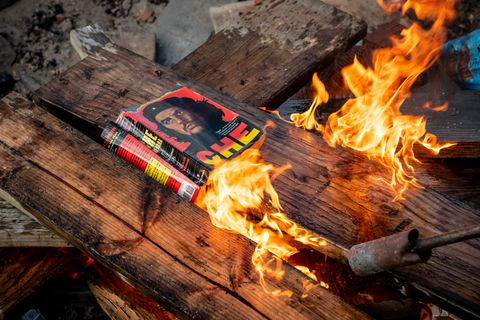 Before starting the July 4 fundraiser in Eatonville, Wash., for Matt Marshall, Craig Hanvey burns a copy of Jon Lee Anderson’s biography of Che Guevara. (Stuart Isett for The Washington Post)
Before starting the July 4 fundraiser in Eatonville, Wash., for Matt Marshall, Craig Hanvey burns a copy of Jon Lee Anderson’s biography of Che Guevara. (Stuart Isett for The Washington Post)Alice Crites contributed to this report.
Photo editing by Karly Domb Sadof. Design and development by Audrey Valbuena. Copy editing by Karen Funfgeld.
Read More:
As Trump warns of leftist violence, a dangerous threat emerges from the right-wing boogaloo movement
The Troll: A fake flag burning at Gettysburg was only his latest hoax

